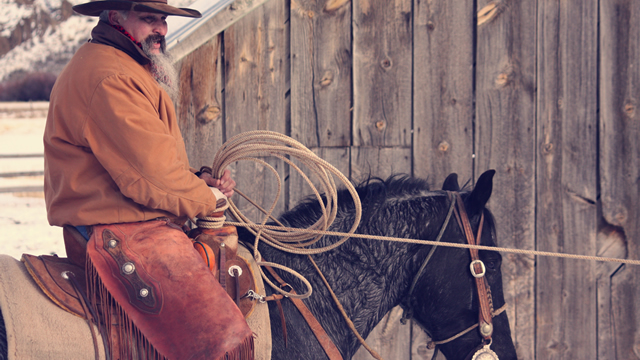Written by Heather Smith Thomas photos by Tessa Gilpin
This article originally appeared in Eclectic Horseman Issue No.54
Handling horses the natural way and producing finished horses that can do anything you ask of them—this is Dwight Hill’s goal.
He raises and trains horses that can excel in many disciplines and his horses are sought after by a growing number of horsemen. His training facility is located near Rexburg, Idaho, but he pastures mares on several different ranches.
“I grew up in Blackfoot, Idaho, and as a kid all I wanted to do was work with horses. Our neighbors had horses and always seemed to have a horse or a colt that was giving their kids trouble. When I was 8 years old they started paying me to start their colts or fix their problem horses. When I was 17, I got to see my first real bridle horse—at a reined cowhorse competition at McCammon, Idaho. The rider was Larry Christianson, on a bay horse named Spook. That horse was awesome and won the bridle horse class, and I thought to myself that someday I would have a horse that rides like that,” says Hill.
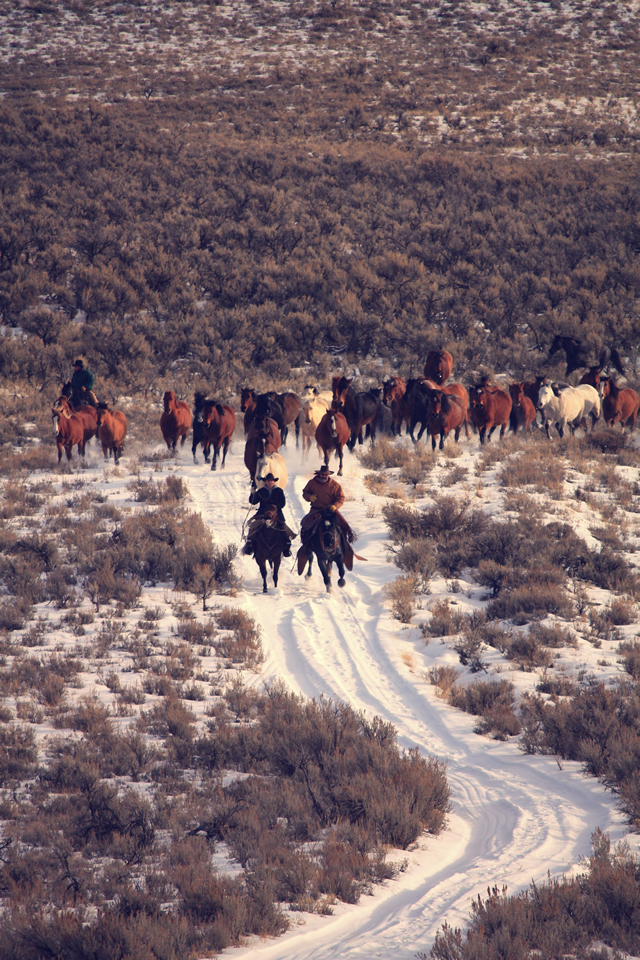
“I introduced myself to Christianson that day and we became good friends. I started riding with him and he helped me with my horse training. Another friend of mine, Scot England, worked for another reined cowhorse trainer and we got to riding together also, and this really sparked my interest. I began training more horses and my goal was to produce finished bridle horses.”
When Hill was 27 he was finally able to compete against his mentors in a bridle horse class and win. “I beat them on a stud horse that I trained myself. That was a great moment. I still have that horse; he’s 17 years old now and still one of the nicer bridle horses I’ve ever made. Most of the young horses I’m riding now are by him.”
The stallion’s registered name is Smoke’s Cheetah. “I bought him over the phone sight unseen. I’d seen another stallion in Bozeman, Montana, and asked the lady where she got that horse. She told me, so I called the guy and asked if he had any horses like that one. He said he had a weaned colt that was in his opinion a better horse. So I told him I’d buy that colt,” says Hill.
“I took him through all the steps—from the snaffle bit to the hackamore to the two rein to the bridle. When he was 4 years old I took him to Reno to the Ranch Hand Rodeo and one part was a stockhorse competition, which he won. He was the only stud at that show and the only horse in the hackamore. They had what they call the top horse award and all the cowboys vote on it, and my horse was voted the best—out of 207 horses,” recalls Hill.
The dam of this colt was Doc’s Cheetah, a daughter of Doc Bar. “The year my colt was born, they inducted her into the Reined Cowhorse Hall of Fame. She had 27 sons, daughters, grandsons and granddaughters in the top 20 in the world, in reined cowhorses. Her son (my stallion) and his colts have been the basic reason my name is now on the map for performance horses, along with the influences of Larry Christianson and Scot England when I was young. And, I always made a point when I took my horses to town, whether to a ranch roping or stock horse competition, to be mounted the best I could be. That sells more horses for me than anything, to be always riding a good horse,” says Hill.
RAISING THE GOOD ONES

He got into the breeding business early on. “This wasn’t my goal originally, but I got tired of driving around the country trying to find the kind of horses I wanted to ride. I looked into the Gunsmoke-bred horses and I loved them; they just fit me. At that time in the horse industry these colts were bringing $2500 to $3000 right off the mare and the fillies you could buy for half that. So I started buying these well-bred fillies and riding them, getting them going. After they got older and I needed to be riding colts, I decided to breed those mares. I had this good stud horse and I liked him really well, so things just went from there,” explains Hill.
“I was working for Mitch Jacobs at Hamer, riding colts for him, and at night after work I was riding colts at a friend’s barn, a guy named Merlin Boulder, here in Rexburg. I was riding as many horses at night as I was during the day at Mitch’s place, and it got to the point where I needed to decide one way or the other and I chose to just ride my own horses. I bought this place and started training horses.”
For awhile he was running 200 mares and had broodmare bands in 3 different states, but later sold down and now has about 130 mares. Today he has mares at Ten Sleep, Wyoming, and a set of mares in the Pahsimeroih Valley of Idaho and Antelope Creek, near Mackey, Idaho.
“With the economy the way it was, I had to sharpen my pencil and cut way back on numbers. I kept only the mares that raise the very best colts and I think I can make more money with less horses. I have enough of these really good young fillies to continue on with. I think if a breeding program is the way it should be, each new generation should be better than their parents. I got rid of some older mares to make room for the fillies I’ve been raising,” he says.
He rides some of the fillies before he breeds them. “If I don’t know their mothers I will definitely ride them, to make sure they have a good mind. If they don’t have a good mind, I am not going to breed them.” He feels 70 percent of a foal’s attitude and disposition comes from the dam. She has a big influence on that young horse the whole time he’s growing up, until weaning.
“Ever since I got rid of the mares that were wild-acting or bad dispositioned, I can now throw 100 head of mares together and 2 people can trail them anywhere you want to go. I now have my breeding program to the point where I can show someone a weanling and tell that person how that young horse will ride and what it can do. I am familiar enough with my broodmares and studs and how they cross that I can tell the buyers—when they get these colts as yearlings or two-year-olds (even before they get their hands on them)—how they are going to start and how they will ride,” he says.
He can fit the horses to the buyers and know they’ll be a good match. “If they want a performance horse to show, I can offer that, and if they want one that will be easy-going and laid back that everyone in the family can ride, I can show them colts that will work that way. It’s been a 25-year process, but now I know my horses well enough to be able to do this. The only way to get this kind of knowledge about them is to ride them,” says Hill.
His mares run at pasture all their lives and he gathers the foals at weaning time, bringing them in for winter. In the spring he brands, castrates and halter breaks the yearlings, teaching them to lead, then turns them back out on pasture for the summer.
Raising horses in big pastures is a good way to raise sound, sane horses. They know how to handle themselves in rough terrain, and they have good minds. “The first 2 years of their lives they’ve spent summers running out in the brush and rocks in the mountains,” he says. They develop good feet and legs and agility and can handle themselves in any situation. When you ride them, you don’t have to worry about badger holes because they look out for those, and they trot through brush and obstacles like they’ve done it all their lives. It’s quite a contrast to some of the horses he trains for other people; many of those horses are raised in small pens and pastures and don’t know about the real world. Some don’t even know how to cross a creek.
More and more people are hearing about his horses and want to own one. “I’ve been doing this long enough now that I’ve sold horses from Canada to California to Florida. The colt I sent recently to Florida went to a family whose daughter was the national high school rodeo breakaway champion roper. I am sending a horse to Calgary, Canada, and have several horses in California. We went to a high school rodeo the other day and I counted 7 horses there that I’d raised.”
Some customers like his horses for ranch and general cow work. “Everything I raise is bred to watch a cow, even barrel horse prospects. My daughter is into barrel racing so I cross my cow mares with a running bred stallion (a Dash For Cash horse). Those colts will really watch a cow. I tell people that every horse, even a barrel horse, needs a little cow. It gives them thinking ability and natural rating. They are athletes, and just because they are cow bred doesn’t mean they can’t run. My 17-year-old stud can still run faster than most horses. He’s an awesome all-around athlete. Cow breeding gives these horses a little more thinking ability instead of just reacting. Too many running-bred horses tend to react rather than think; they are too volatile.”
He doesn’t change his training program for any specific discipline. He handles the rope horses, reined cow horses and potential barrel horses all the same. They all get a good foundation and can go into any specialty. “They all have to learn to flex and bend, and be soft in all their body parts and have a willing attitude. If they can do that, it doesn’t matter what discipline you go into. They are prepared to handle it,” says Hill.
TRAINING METHODS
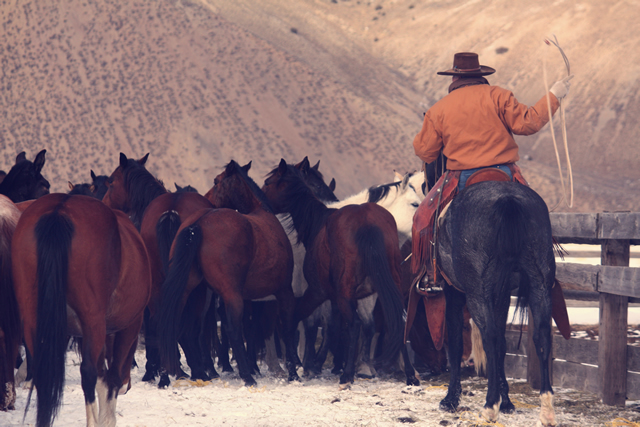
“I bring the young horses in, the fall of their 2-year-old year, and put 10 rides on them. I start them in a round pen, using natural horsemanship techniques. Most of my colts respond quickly; I am really disappointed if I’m not on his back 30 minutes after I put one in the round pen.”
He starts his horses the same basic way most of the clinicians do today. “I’ve done a few clinics myself. This all goes back to Tom Dorrance. I think he is the godfather of the way horses are being trained today. I try to use his methods, but I’m not even close to his caliber of horse handling, but it’s the same general principle. I try to let what I want the horses to do become their idea—the basic philosophy of natural horsemanship,” explains Hill.
“I put them in a round pen and play with them, roping all parts of their body and get them used to that. I get them used to me and relaxed, then I put a saddle on and let them wear it awhile. The first ride, I just ride them in a halter. The second ride I introduce them to the snaffle bit. By the 5th or 6th ride I am usually riding them outside and down the road or through the brush.” The good-minded horses are always ready for the next step. There’s no confrontation; they are receptive to what you want them to do.
“I am not doing anything different than Buck or Bryan Neubert or any of those guys. I’m just trying to perfect it with every horse and try to do better with them.” Every horse teaches you something more. They are all a little different, and the best teacher is the horse.
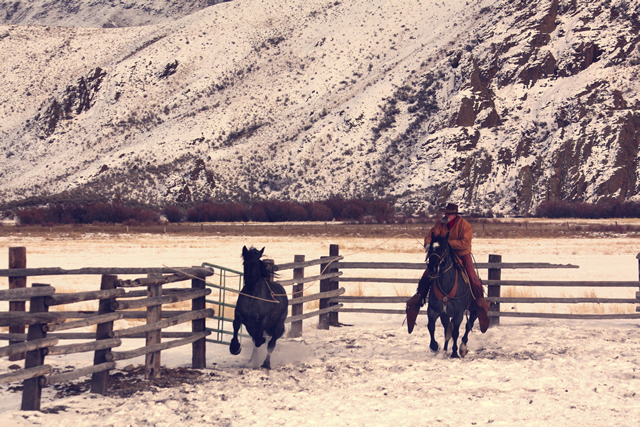
“We have to keep our minds open to listen to what the horse is telling us. You have to be listening to the horse as much as you want the horse to listen to you. For every action there’s a reaction. Communication is a two way street. Until you are humble enough to realize that, you’re not going to become the horseman you want to be,” says Hill. For instance, the horse will always tell you how much he can do that day, and you’ll know when to quit.
“A really good horseman who had a lot of influence in my life told me some things that stuck with me. When I was preparing young horses for showing in reined cowhorse competitions, he told me to look at it this way: Don’t try to get a 10 percent improvement every day. Just make sure you get 1 percent improvement each day. What will you have, then, at the end of 100 days? You’ll have 100 percent. If you try for 10 to 15 percent improvement you might go 20 percent ahead today but you might go 25 percent backward tomorrow.” If you overdo it, you may go backward and ruin a lot of good training.
“I try to keep that in mind, and look for a little improvement each day, and I always try to end on a good note. It doesn’t matter whether I’m working with a colt or practicing my roping. I always tell my kids, when they miss one we’ve got to rope one more because we don’t want to end up on a bad note—or you dwell on the negative until the next time and that’s all you think about. The colt will do the same. If you had a battle with him and don’t resolve it and become friends again, the battle is what he’s going to remember and that’s all he’s going to be thinking about,” says Hill.
“It’s the same with your kid. I use my same training principles with my kids as I do with my horses and it seems to work,” he says. “You need the same patience and openness, yet you also need some discipline. You need acceptance and respect. Respect is a two way street and you have to earn it,” he explains.
“And, you should never pack a grudge. Some people have told me their horse bucked them off, so they hate the horse. The first thing they need to do is change their attitude. If you don’t change your attitude toward the horse, there’s no point in going any farther. Why did the horse buck them off? You have to go back and find out why the horse bucked. The horse is in self-preservation mode when he bucks you off.” The rider did something to startle or upset the horse, or put him in a bind he wasn’t comfortable with, so bucking is the horse’s reaction. The rider needs to look to himself to find the problem.
“I tell people the horse is like their wife. They both respond to the way you treat them. Horses have helped my human relationships a lot. If you can humble yourself long enough to listen to the horse, you’ll get ahead as a trainer, and in life. If you can humble yourself and listen to a person—if you listen long enough, you’ll find out the true reason why they’re mad or that you messed up. If you just explode and come right back at them, it will be a big fight,” says Hill. You must be open to the horse’s side of things.
His young horses are all handled briefly as yearlings, and this sets the stage for later training. They were tied up and taught to lead during the spring of their yearling year. “I get them in, handle them, tie them up and play with them at that point in their lives. This is also when I work them and brand them, castrate the colts, etc.” This gives him a good idea about the personality of each young horse.
“I can tell when I am breaking them to lead. If an individual is acting badly I will lay him down as a baby, and hold him awhile on the ground until he accepts me. Then when I let him up, he has more respect. By the time these horses are ready to start as 2-year-olds, they know what humans are. They still have their self-preservation instinct, but they respect people,” explains Hill.
He puts 10 rides on them that fall to make sure they can carry a rider nicely and lope a good circle. “I make sure I don’t have a problem child at that point. I haven’t had one be a problem for a long time, but if at that stage one is a little humpy, I ride him until he’s over it. Usually 10 rides is enough, however, and I turn them back out until the spring of their 3-year-old year. I get them back in then, and they go to work.”
He rides them for half a day, takes them to brandings, uses them to gather cattle, and may drag 6 or 8 calves with them, then uses a mature horse to finish the day’s work. This way the young horses learn a lot but are not overworked. As 3-year-olds they can handle a little work. Some people start training and campaigning 2-year-olds and they’re too young to handle it, both physically and mentally. They need that extra year to grow up. Maturity is important in both mind and body.
They get turned out after their first lessons as 2-year-olds, and it’s like summer vacation for kids. “If they went to school year-round they’d get sour. These colts have 10 rides and they know what the program is. That next spring I get them in and put 5 or 6 rides on them and then I can go brand on them,” says Hill. They are ready to handle it.
“I always try to end each session on a good note, so the horse is happy and everything is working well. If I drag 5 calves and that horse is happy, I quit. I always have a couple older horses with me that I can finish up on. By the fall of their 3-year-old year they are broke, and ready to go do whatever you want. If you want to show reined cow horses, I’ve already had them on a cow. They are ready to go into a hackamore and progress in their training that way, and the next year they’d be a 2-rein horse, and then a bridle horse, if I can keep them that long,” he says.
IMPORTANCE OF VERSATILITY
Many people call him to ask about each year’s crop, wondering if he has another horse related to one they already have. He now has horses in the ranching world, rodeo, reined cowhorse competitions, barrel racing, etc. and they are all the same kind of breeding. “One full brother might be a team roping horse and another a barrel horse, and another that’s a straight-up bridle horse being shown as a reined cowhorse,” says Hill.
The horses he raises and trains are versatile enough to do well in many different disciplines. He feels some people try to breed horses that are too specialized. It’s better to have the athletic ability and versatility to do a lot of things. “Horses are no different than humans; individuals tend to have more talent in one area than another. I know I would never make a rocket scientist, and there are a lot of rocket scientists who won’t make horsemen. Horses are the same way. Just because they are not exceptional in one thing, there is something they can do well,” he says. And they can be good at a lot of different things even though they might not be the very best in some of those things. They can handle many things and do them well.
“That’s what I’m breeding for. I want an athletic horse that has a good enough mind that it can make a family horse and still go out and compete. My stud is a good example. When my youngest boy was 6 years old he was roping calves on that horse.”
HANDLING STALLIONS

His stallions are used all the time. Hill won’t breed a young horse until that horse is broke to ride. “By then I know whether I really want to use him as a sire, and he also knows the rules. I don’t hand breed these stallions. Even if I have a mare here at the place I need bred, I put the 2 horses in the arena and turn them loose. That stud knows that any time I catch him, he must pay attention to me, and not mares. Then when I turn him loose with a mare, he can go ahead and be a stud horse again,” explains Hill.
“My stallions are always gentlemen, and easy to handle. They don’t make me walk into the stall to catch them thinking they are going to be hand bred and walking on their hind legs and being rude.” It’s always clear in their minds that when they are caught they are going to work; they only breed mares when they are loose. Using them for work is good for their minds and physical fitness.
“They are bred to be performance horses and are happiest out there doing something. You don’t put them on a shelf until breeding season. You can go ahead and use them and they stay happy,” he says.
The young stallions learn how to behave around mares, since they are never hand bred but have to run with the mares and court them the way nature intended. They learn social manners and herd pecking order, and respect for the mares. Without this kind of experience a stallion would get hurt. Even so, one does occasionally get hurt. “I lost a really nice stud last spring after a mare kicked him and broke his leg. This is just part of the deal. There are some risks running the stallions with the mares, but I have a better conception rate pasture breeding than people do with hand breeding,” says Hill.
Pasture breeding is more natural, and healthier for the horses. The stallions stay more “sane” because they are not confined all the time, and have plenty of exercise. “It’s more real. It doesn’t matter what I am doing with horses, I like it to be real—whether I am roping, training, or breeding. The studs are out there herding the mares and learning how to keep them together. The mares won’t stand for breeding until they are truly ready to breed, so the studs learn manners.”
The best thing for any young stallion who is too full of himself and disrespectful, wanting to dominate people, is to turn him out with a group of pregnant mares. They will soon teach him manners, and educate him a lot easier than you can. He learns that he’s not the boss and must respect his superiors. “There’s a pecking order in everything. That young horse learns he isn’t the dominant one in the relationship.”
KEYS TO SUCCESS
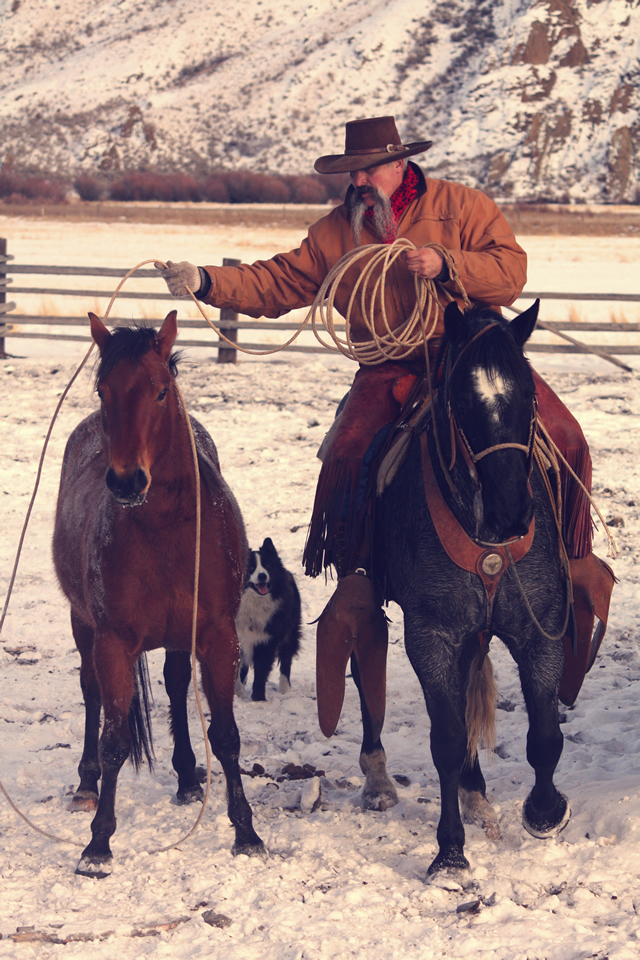
“My theory about how to succeed in business, and my advice to anyone starting out, is to find what you love to do, and do it. That’s the only way you’ll ever be the best at it,” says Hill.
“Some of my horsemen friends are jealous of my success because they had to take some other type of job to support their family—and I respect that idea, that you have to do whatever you can to support your family.” But if there’s something you really want to do, you will be happier if you try to do it. If you want to do something badly enough, you’ll find a way to do it, and make it work.
“I’ll never be a rich man. Charlie Russell said that in his eyes, the rich man wasn’t measured by money but by the number of friends he has. In that aspect, I feel like one of the richest men in the world. I have friends all over the country, and I can drive from here to California or to Arizona and stay at a friend’s house every night along the way—so I feel like a very lucky man.”
People who are doing what they want to do are very lucky. “We come into this world with nothing and go out with nothing, but we can have a lot of good experiences in the meantime. You can’t take money with you, but you sure can leave a lot of good memories behind.” His biggest goal in life is for people to say, “He was a good dad, a good husband, and a good horseman.” These are great goals, and he says he’s still working on them—still learning.
He learns from every horse he trains, and from people. “That’s what I like about putting on clinics. I tell people that there is no stupid question; they can ask me anything they want. I still feel like I learn more from my clinics than the people do. They ask questions that make me think—things I have to try to explain to them, and try to define situations that I’ve never thought about because I’ve always taken them for granted.” He has to figure out how to put that into words and explain it to someone.
“I love questions, and I encourage questions, because it makes me think.”
This article originally appeared in Eclectic Horseman Issue No.54

